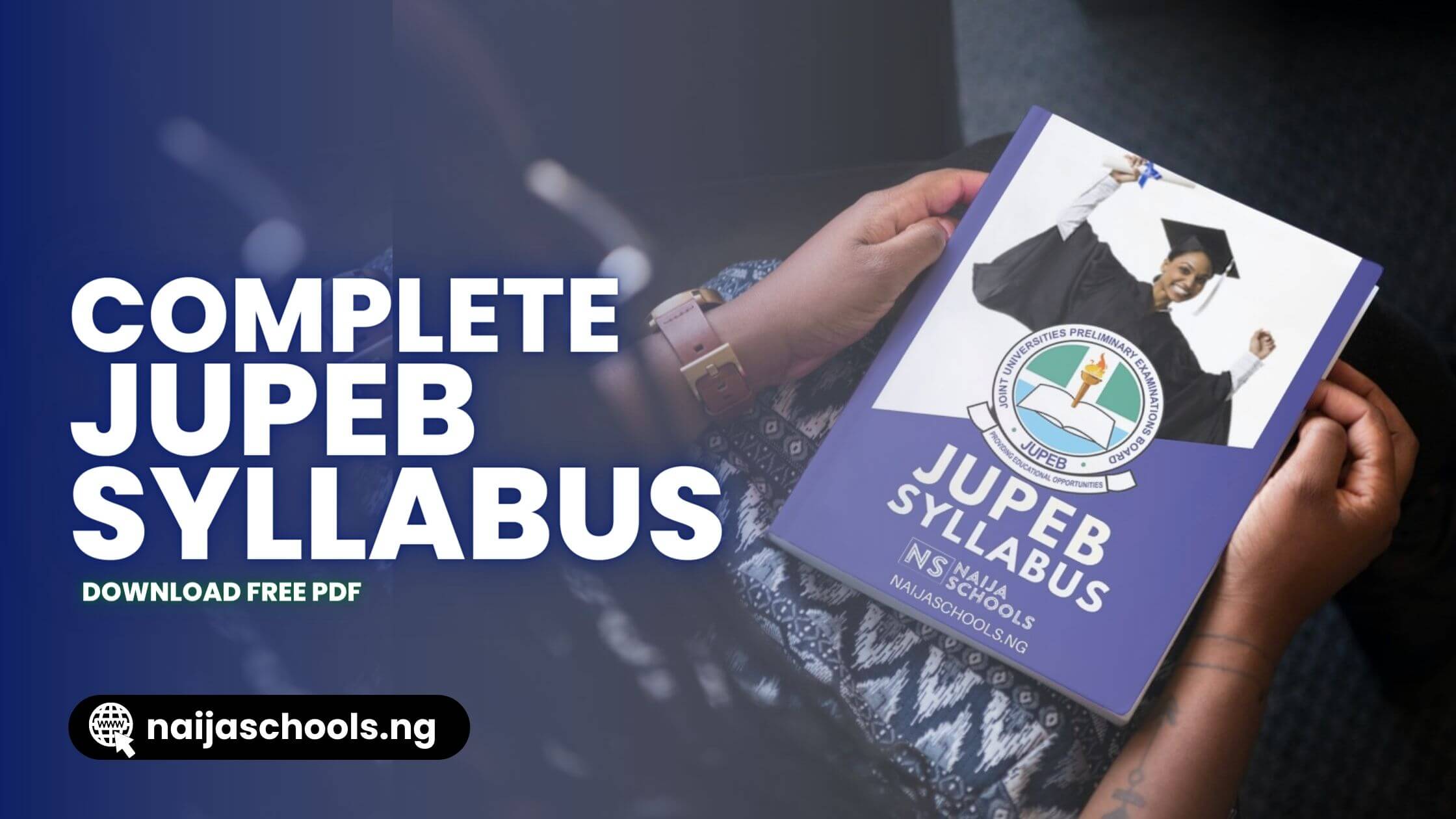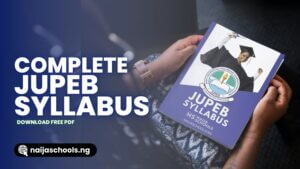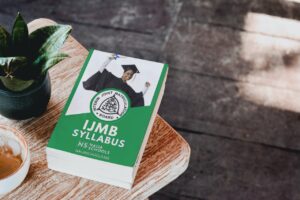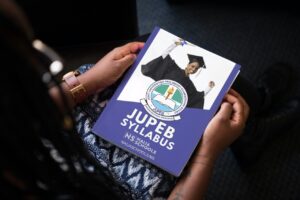General Objectives of the Visual Arts JUPEB Syllabus
At the end of the series of courses, the candidates should be able to:
- Demonstrate the ability to work from direct observation and personal experience;
- Display a creative and critical approach to solving problems;
- Display confidence in solving problems in visual forms;
- Develop lifelong technical skills;
- Demonstrate their knowledge of the historical and theoretical foundation of each of the subject areas;
- Develop confidence in handling two and three dimensional art projects;
- Produce two and three dimensional practical projects;
- Select a possible area of specialization when admitted for the full degree course;
- Develop entrepreneurial skills in the visual arts
Courses:
The Visual Arts JUPEB Syllabus is divided into four (4) course units which will be treated during the JUPEB program.
First Semester Courses
- VSA 001 : Art History 3 Units
- VSA 002: Two Dimensional Design 3 Units
Second Semester Courses
- VSA 003: Three Dimensional Design 3 units
- VSA 004: The Decorative Arts and other Craft traditions 3 Units
Detailed Syllabus
VSA 001: ART HISTORY 3 Units
Specific Objectives
At the end of the course, the candidates should be able to:
- Identify a broad range of paintings, sculptures, installations and other artistic creations from various cultures of the world;
- Demonstrate their knowledge of trajectories of various artists and art events across the globe;
- Show ability in critically evaluating different styles and movements in the arts: a
- Evaluate historical, social and cultural context of art production
Course Content
A general survey course that would deal with an introduction to European art and African Art- Art of the renaissance period, various artistic movements, cubism, expressionism, post modernism, modernism, impressionism etc. A general introduction to the arts of Africa- brief studies on African artists and movements . A short assessment of various artistic movements, heritage sites, museums, monuments and art workshops in Africa.
- Art Movements – Abstract Expressionism, Surrealism, Cubism, Abstraction, Pop Art, Minimal Art, Conceptual Art, Expressionism Issue- based art and globalization
- Renaissance Art of Europe
- Nubian and Egyptian art- A general overview
- African Art of the Sub-Saharan region- Masking traditions, Classical sculptures from Nigeria, Nok, Igboukwu, Ife, Benin, Tsoede, owo, and such other artistic traditions
- Identification of works of artists across the globe- Pablo Picasso, Paul Cezanne, Bruce Onobrakpeya, Yussuff Grillo , Malangatana Valente, David Koloane, El Salahi, Skunder Boghosian
VSA 002: TWO DIMENSIONAL DESIGN 3 Units
Specific Objectives
At the end of this course, candidates should be able to:
- Interpret the principles and elements of design as it applies to two-dimensional art;
- Use colours appropriately;
- Identify and research an area of art and design
- Explore the use of a variety of materials or media and processes in two dimensional design
Course Content
The course provides an overview of the entire range of courses categorized as two-dimensional art. For these range of topics, candidates will be introduced to various aspects of the theory, materials and methods. These include painting, textile, Graphics, Photography and drawing. Practical assignments are also to be carried out.
Painting
Painting would introduce the candidates to various materials and methods in drawing as well as in painting. Candidates are to have a broad understanding on various media such as charcoal, oil, gouache, water colour, and acrylic. They should be taught to explore tone, colour, composition, context and media. One practical assignment on any three of the topics listed below should be submitted for evaluation.
- Landscape and Seascape
- Drawing- general drawing from nature, still life, imaginative composition
- Figure Studies
- Still- life
- Portraits
Textile
Candidates are expected to demonstrate their ability at using fabrics, fibres, dyes and textile paints in producing art that is engaging as well as functional. Traditional processes of tie and dye, batik, weaving, printing and painting are to be taught.
One practical project exploring the candidate’s ability to produce engaging textile art would be assigned deriving from any of the topics listed below.
- General knowledge of tools, materials associated with dyeing, screen-printing techniques and on and off loom processes. Basic design for textile production and use of colour and principles of design.
- Dyeing as an art- A general discourse of textile traditions in Nigeria and Africa as a whole. An introduction to the socio-cultural significance of cloth in Africa. The course would also expose the candidates to the various fabrics that abound in Nigeria -Sanyan, Akwete, Kijipa, and Etu. Kente cloth from Ghana, Kanga and Mud cloth from Mali. Textile production centres such as Asoke weaving in southwestern Nigeria, cloth dyeing in Kano, Abeokuta. It would conclude with studies on contemporary usage of cloth, dress and textile.
- Methods and techniques of dyeing fabrics and fibres- processes of batik, stitching, and other resist methods.
- Methods and techniques of silk painting, screen printing, painting with fabric acrylics
- Textile construction. Using fibres through the stitching, knotting, weaving or looping technique. Using alternative media in addition to fabrics and fibre to explore other creative means of making two dimensional or three dimensional designs
- Exploring fashion- making of fashion accessories, garment construction, body adornment, and other fashion accouterments. Designing costumes, set design and props.
Graphics/Photography/Printmaking
This aspect would provide a survey of techniques involved in graphic art production. Photography, printmaking, designing on paper and a survey of computer graphics areas to explore in both theory and practical exercises. One practical project is expected which can be selected from any of the three options under graphics listed below. Participants should leave with a clear overview of the principles of design.
Various printmaking methods taught should include (Option 1)
- Relief printing
- Lino print
- Monoprint
- Etching
- Screen printing
- Collagraph
Various techniques of photography should include (Option 2)
- Depth of field in photography
- Lighting
- Tone and colour
- Framing
- Film speed/ shutter speed
- Editing
- Transitions
- Developing of films
- Experimentation- image scanning and manipulation with the computer, using creative spaces for photographic work, darkroom practices and multiple exposure methods
- Still Imagery.- creating and presenting images as powerpoint, pho shop techniques, website development and the use of sound for both still and moving images where appropriate; and
- moving imagery production- students should be introduced to various processes and techniques beyond presentation of still images alone. These would include animation, power point, digital editing- making short documentaries, creating story boards, use of sound and moving images,
Graphic art and design (Option 3)
- Illustration techniques – lettering and designing for posters, magazines, billboards, brochures and leaflets
- Advertising-students should demonstrate their ability in graphic communication. How to sell a product- logo design, posters, billboard and signposts
VSA 003: THREE DIMENSIONAL DESIGN 3 units
Specific Objectives
At the end of this course, candidates should be able to:
- Demonstrate a theoretical and practical understanding of three Dimensional art forms; and
- Model three dimensional forms in clay
Course Content
This course provides a survey of three dimensional art forms such as ceramics and sculpture. Candidates are expected to learn about the various materials and methods of Sculpture and ceramics. They should be conversant with technical terms as well as processes of production
Sculpture
Under sculpture, students would explore the basic theory of modeling, relief work, assemblage and casting. There will also be a practical assignment in any of the topics listed below showing the candidate understanding of the processes involved.
- Materials and methods in sculpture
- Making simple forms and relief sculpture
- Studies in sculpture in the round
- Casting techniques in sculpture
- Metal assemblage
Ceramics
Theory of materials and methods of ceramics. Practical classes to cover modeling and hand building techniques, wheel throwing and various ways of improvising. One practical project would also emanate from the series of topics listed below.
- Terminologies associated with ceramics- bisque, greenware, grog, kiln, cones, oxides, kaolin, ball clay.
- sculpting in clay using various techniques- hand building, slip casting and wheel throwing techniques, slab building, drying, firing, decorating and painting with slip and oxides, glazing.
VSA 004: THE DECORATIVE ARTS AND OTHER CRAFT TRADITIONS 3 Units
Specific Objectives
At the end of this course, candidates should be able to:
- Identify various craft traditions
- Produce a practical project in the decorative arts or crafts peculiar to any culture the student is familiar with
Course Content
Candidates would be taught various methods and materials in simple jewelry production such as Bead stringing, simple metal casting techniques, sheet metal work and using found objects. Other indigenous art traditions as well as an emphasis on recycling art. Such other crafts include basket weaving, paper mache art, and wirework. There will be one practical project in beadstring or any other area listed below.
- materials and methods of jewelry manufacture.
- Exercises in beadstringing, worework
- Simple casting procedures, cire perdue, centrifugal casting, cuttlefish casting, sandcasting techniques.
- Exploration of Indigenous materials , stones, bones, shells, wood, buttons, paper and fabrics
Expectation
At the end of this course the candidate is expected to submit one critical literary paper that shows an understanding of the theory and history of the arts as well as six practical projects from the various two and three dimensional as well as craft areas identified. These practical works would serve as the candidate’s portfolio.
Reading List
- Mark Antiff and Patricia Leighten (2001) Cubism and Culture, Thames and Hudson, London.
- Egonwa Osa. D; (1996): African Art History
- Audio visual Aids e– learning materials. The Women and Youth Art Foundation series in
- beadwork,
- Goldsmithing,
- wirework and
- Tie and Dye
- Scott Kelby (2006) The Digital Photography Book
- The Art of Photography: An Approach to Personal Expression by Bruce Barnbaum (2010)
- History and Practice of the Art of Photography by Henry Hunt Snelling (2012)
- The Photographer’s Eye: Composition and Design for Better Digital Photos by Michael Freeman (2007)
- Digital Landscape Photography: In the Footsteps of Ansel Adams by Michael Frye (2010)
- BetterPhoto Basics: The Absolute Beginner’s Guide to Taking Photos Like a Pro by Jim Miotke (2010)
- The Art of Photography: An Approach to Personal Expression by Bruce Barnbaum (2010)
- The Photographer’s Eye: Composition and Design for Better Digital Photos by Michael Freeman (2007)
- Ceramic Design Course: Principles, Practice, and Techniques: A Complete Course for Ceramicists by Anthony Quinn (2007)
- 250 Tips, Techniques, and Trade Secrets for Potters: The Indispensable Compendium of Essential Knowledge and Troubleshooting Tips by Jacqui Atkin (2009)
- The Ceramics Bible: The Complete Guide to Materials and Techniques by Louisa Taylor (2011)
- The Essential Guide to Mold Making & Slip Casting (A Lark Ceramics Book) by Andrew Martin (2007)
- Alternative Kilns & Firing Techniques: Raku * Saggar * Pit * Barrel (A Lark Ceramics Book) by James C. Watkins and Paul Andrew Wandless (2006)
- Ceramics for Beginners: Wheel Throwing (A Lark Ceramics Book) by Emily Reason (2010)
- The Complete Jewelry Making Course: Principles, Practice and Techniques: A Beginner’s Course for Aspiring Jewelry Makers by Jinks McGrath 2007)(
- Computer Graphics: Principles and Practice in C (2nd Edition) by James D. Foley, Andries van Dam, Steven K. Feiner and John F. Hughes (1995)
- Art: A World History by Elke Linda Buchholz, Susanne Kaeppele, Karoline Hille and Irina Stotland (2007)
- Art: A World History by DK Publishing (2002)
- World Art History and Its Objects by David Carrier (2009)
- The Printmaking Bible: The Complete Guide to Materials and Techniques by Ann d’Arcy Hughes and Hebe Vernon-Morris (2008)
- Block Printing: Techniques for Linoleum and Wood by Sandy Allison and Robert Craig (2011)
- The Complete Printmaker: Techniques, Traditions, Innovations by John Ross (1991)
- A Handbook of Indigo Dyeing by Vivien Prideaux (2012)
- Dyeing and Screen-Printing on Textiles: Revised and updated by Joanna Kinnersly-Taylor (2011)
Download the Visual Artis JUPEB Syllabus (PDF)
Click on the “Download” button to download the JUPEB syllabus for Visual Arts in PDF format.
Recommended Articles
- JUPEB Syllabus For All Subjects — Free PDF Download
- CRS JUPEB Syllabus — Free PDF Download
- French JUPEB Syllabus — Free PDF Download
- History JUPEB Syllabus — Free PDF Download
- Igbo JUPEB Syllabus — Free PDF Download
- Islamic Studies JUPEB Syllabus — Free PDF Download
- Literature in English JUPEB Syllabus — Free PDF Download
- Music JUPEB Syllabus — Free PDF Download
- Visual Arts JUPEB Syllabus — Free PDF Download
- Yoruba JUPEB Syllabus — Free PDF Download
- IJMB Syllabus For All Subjects — Free PDF Download





